Bridging the Gap between Teachers and Students
A Look at How Storytelling with ChatGPT and Stable Diffusion Playground is Enhancing the Learning Experience

Summary
I’d like to share a long read about a trial storytelling session with a small group of undergraduates in a professional communication course. I asked them to share their hopes and fears in relation to their learning experience with English. The prompts were both verbal (a question) and visual (picture cue cards) — I sped up the material preparation process with the help of ChatGPT, generating prompts for creating images with Stable Diffusion Playground. It was just one session, but I could sense that some students loosened up a little bit in the class; as they shared having opened up, I understood that perhaps they weren’t uninterested in the course — the feelings were pretty mixed. While I’m doing my best to help them enjoy the class more, it feels great to get closer to them, at a “safe distance” during the session.
What my typical English classroom is like
If you’re in my professional communication or an academic English class, the routine you experience in a lesson would usually be like this:
I chitchat with some of you as I start the lesson, and recap the content of the previous class;
I build the momentum by asking you a few lead-in questions, and you’re expected to answer them verbally or type your answers using online tools such as PollEverywhere;
We go over and discuss your answers; at times I’ll draw on the screen and highlight, correct and comment on your answers;
I bring you back to the subject content, and discuss it with the answers that you’ve given.
Repeat until the end of the class.
Evaluating myself, I don’t think this routine is bad; but in a “teaching and learning” vibe, students typically answer what’s from the book. Hardly do I know about the students. I’ve been thinking, when trying to be friends mayn’t work (students don’t always want to be friends with teachers), and when surveys are boring, how can I know more about what students think and feel about their learning experience?
Storytelling for Understanding
I've been inspired by my friend Wen, who developed and taught a digital storytelling service-learning course just last semester. We went to a refugee centre, met with some of their clients, and listened to two human library sessions. Each told a very different story, and we asked our students to reflect on the two sessions. Our community partner prepared a deck of beautifully illustrated cards, and the students picked their favourites, and shared their feelings about the sessions with the image cues.
The students, many of whom had been shy, started to open up during the reflection session. As they might just give short answers in English in the class, they were able to give full descriptions of the cards, and relate the “meanings” of the images and their thoughts and feelings. After the session, they seemed to be more willing to talk with us, and engage in conversations and activities with children, as far as we observed.
We found that the act of storytelling, aside from the stories themselves, has some kind of a therapeutic effect on the teachers and the students. To students, storytelling with cue cards seems to channel their emotions quite effectively, and empower them meaningfully; I mean, students are given different language and image resources to express themselves. To us, understanding students is our mission and goal. We are glad to see any changes, growth, struggles challenges… so there I go.
Steps for preparing for the “story circle” session
The total time I spent preparing the materials and ideas for the “story circle”, including the printing time, was no more than an hour. This means every fellow teacher with a bit of time before the class can do it. (A big shoutout to my colleague Winnie, who was so kind to print the images for me. Thank you!)
We won’t take the pain to draw pictures ourselves, for we aren’t illustrators in the first place. Even if we were, drawing does take time; drawing pictures that can prompt reflections will never be an easy feat. So I thought about looking for some help from the AI, who could quickly draw wonderful, copyright-free pictures for me. This is where I saved time, so that I could spend energy planning the session.
Creating images with Stable Diffusion Playground
Unless you need to make super realistic human figures with extremely detailed facial features and expressions, using Stable Diffusion Playground will just do for making cue cards of painting or drawing quality. You might use DALL-E or Midjourney, but since they eventually lead up to paid subscription plans for creating more artwork, I’ll just keep using SD because it’s free.
In order to ask SD to draw, you need to know how to give SD your prompts. By “prompts” I mean “the things to say to the AI in a way it understands you and undertakes the task you want it to do”. It could be written as a complete statement, such as
paint an oil painting on canvas with a boy wearing a white T-shirt and green shorts and holding a bunch of balloon. He looks up at the sky in a busy city, with busy adults walking past him.
Or a list of “tags” like
oil painting, canvas, masterpiece, boy, white T-shirt, green shorts, holding balloons, looks up at the sky, busy cityscape, adults walking past him.
Basically, the prompts may mean similar to you, but the AI can read them differently — even the same statement or the same set of tags can still generate different results. But the idea is, if you want something more likely to appear, the tags should be put more in front of the prompt. But what about things you don’t want SD to create in the image? Answer: you need “negative prompts”.
This is because AI is an imaginative assistant: you give it your requirements, and it reads them in its own creative ways. And because it’s imaginative based on what it’s trained with, sometimes the output can be (un)pleasantly surprising. Asking SD to draw hand gestures is very difficult. You might relate if you try to draw hands yourselves — drawing faces is way easier. So you have to tame SD with negative prompts, asking it to not include certain features in the final image. Using the above example to demonstrate, I’d give the negative prompts to make sure there are no
distorted faces, extra hands, extra limbs, deformed limbs, disfigured…
That’s all you need for making SD work for you, though I think this topic deserves (at least) one dedicated post.
Getting prompts with ChatGPT — with negative prompts if possible
For my class, I had known what I wanted and created a batch of images beforehand. But things won’t always sail smoothly, especially when you are to generate an image that can associate a person with particular emotions, while you cannot be too straightforward at the same time, in that it limits the room for students to imagine. In that case, I would come up with prompts that would generate slightly abstract images. Again, thinking up good prompts to let SD make quality artwork can be time-consuming; so the best strategy now is to prompt ChatGPT to create SD prompts based on the themes you want to explore.
In my case, the theme is to create images evoking emotions, or helping students associate their emotions with the image cues. My assumptions are that students might feel relaxed, lost, confident, nervous, and so on, so I prompted ChatGPT to generate one positive and one negative prompt for each emotion to test the results:
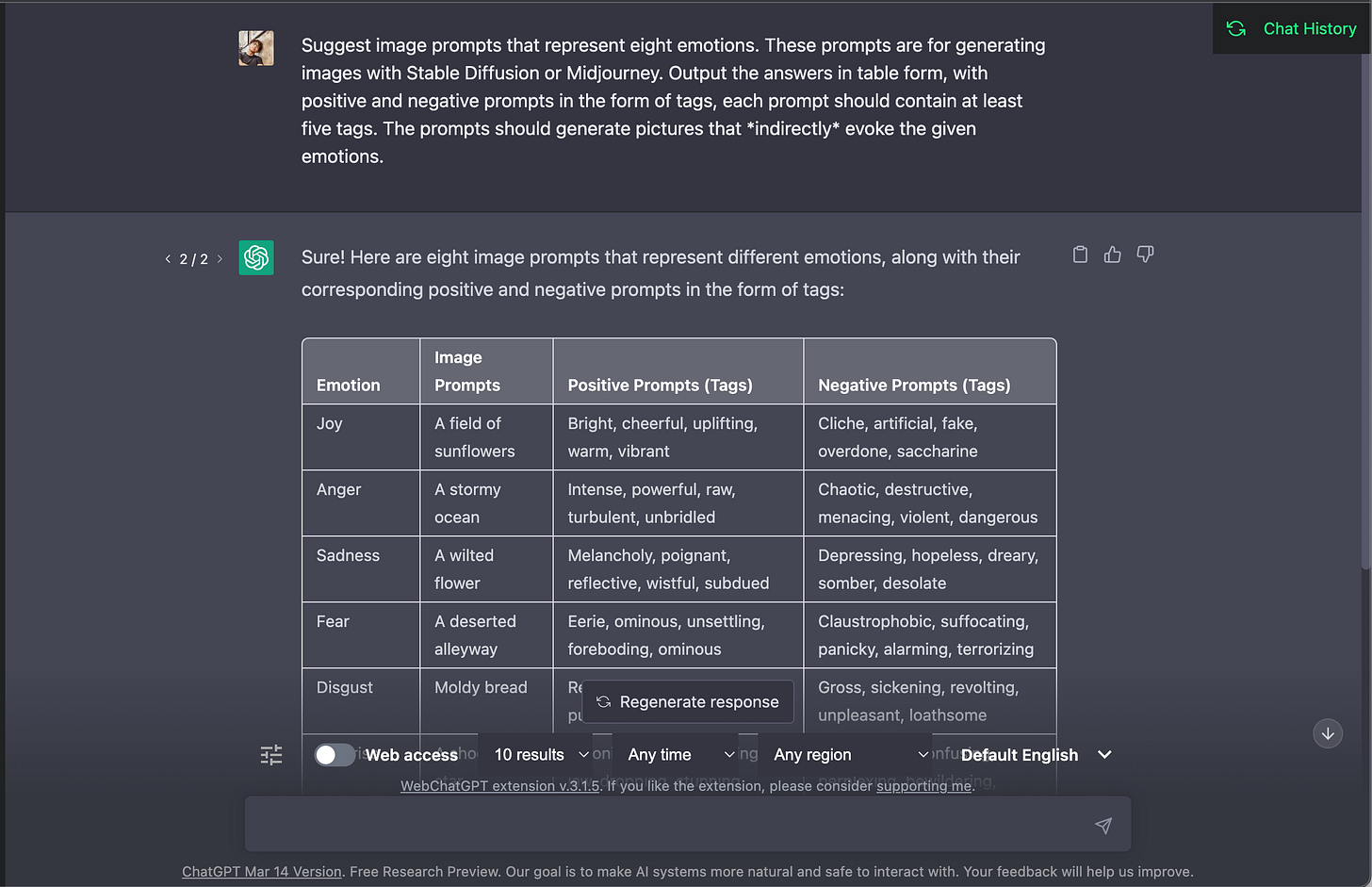
Then I pasted the image prompts to Stable Diffusion Online and get the following results (sometimes the interface doesn't give you the “negative prompt” bar; refresh your DC browser a few times until the bar shows up).
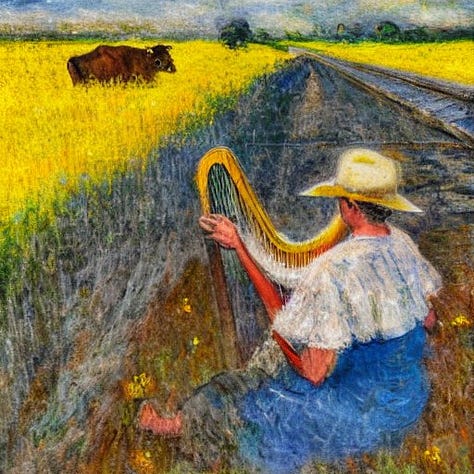


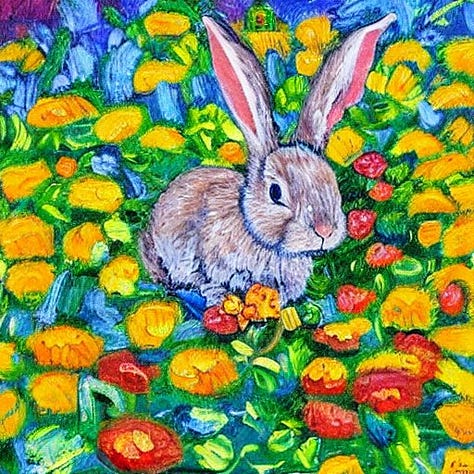



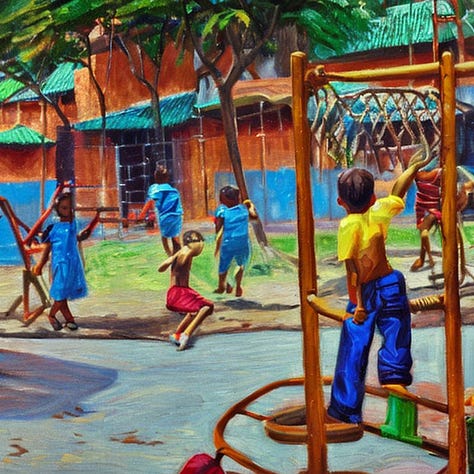
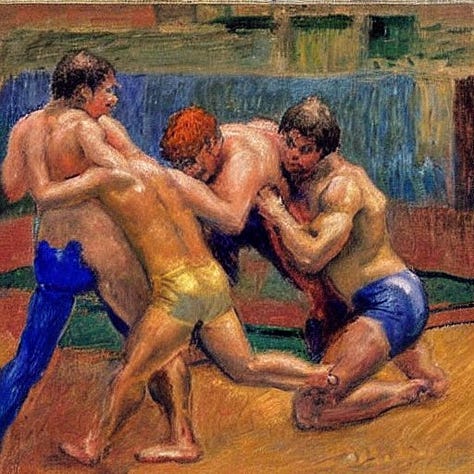
The default output is a squared image, and you can copy four images onto one slide, print the slides out, and cut them into cards. You may laminate them if you want to use them a few more times.
Setting up the session
In this activity, I only used ChatGPT at the material development stage. Students were not involved in using ChatGPT or SD in the process. I tried this session between the interview and the group discussion assessment, when the teaching schedule was less tight, so that the students can be more relaxed sharing their thoughts. Very briefly, after the break, I:
Set up the context. I explained the purpose of the session to them, as I was wrapping up the lesson and wanted a casual chat with them;
Set up the prompt. I asked them, “How do you feel when you must talk with your groupmates in only English?”
Showed students the cards. I laid all the cue cards on a desk and ask students to pick their favourite, or one that could help them answer my question;
Demonstrated once. Before we began, I showed them how to describe the image, and how to find the connection between the image and my feeling;
Sat in a big circle, so that everyone can see each other clearly. It’s also a cosy setting making them feel less intimidated
Asked students to take turns and share. All my students are Chinese, and have a natural fear of speaking openly in English. To make sure the session worked, I asked them to share in either Chinese or English, as long as they can say something.
Alternatives are that you can buy card decks such as Dixit, or copyright-free photos from websites such as Unsplash, if you wish to go for photorealistic images. The key is that you need to plan ahead, like how much space you’re giving the students to imagine with the prompt, or whether you’re actually trying to guide them to think a particular way.
What I learned from my students
Quiet students had a chance to open up themselves. Sometimes I feel anxious about students who are not really up for answering questions in class, not really because they aren’t able to, but more like they don’t want to, or scoff at the idea of answering. Fortunately, in the sharing session, a couple of quiet students did speak up. I was also surprised that, although I said they could share in Chinese, some of them insisted on speaking English. I truly appreciated that.
Some really shared deep feelings about their hopes and fears. Common feelings were nervousness and a sense of loss. There was one student who struggled with understanding anything I said in the class (they used an AI translator to turn what I said into Chinese). They picked a cue with a tree on the grass in an impressionist style, and reflected that there was a sense of envy seeing others were able to understand English so well and “glitter” in the class. After the class, I told the student if they needed any help, they could feel free to reach out to me. I hope they will.
Some of them picked the cards simply out of the fact that they liked the pictures. I don’t blame them. It’s cool, as long as they could connect themselves with the cards, and they found it okay to share. At least I knew a few students felt comfortable and confident, while a lot of them struggled to different extents.
What I could have done better
I could have shared the essential vocabulary for expressing emotions. if using English is a must, or has been the class’s struggle, I think it’s natural to start with a range of expressions and vocabulary for them to use. It may be a better way to encourage them to try speaking English more. But anyway, the end goal was to have them open up in a light-hearted manner, so thinking retrospectively, this might be optional.
I think I should have given them a “narrative” structure to work with too. Again, if I had planned this session more carefully, this part should have been one that encouraged students to think about “growth”: they’re on this “quest” of study, meeting with “challenges” and “villains” (me); they might see this as an opportunity to grow, and visualize their future successes getting against all odds. That said, the question is: should the teacher give students some insights or advice after they share, without denying their negative thoughts or imposing too much on them?
Closing
This was the first time I incorporated generative AI to accelerate my teaching prep process. I know that there are lots of strategies encouraging teachers and students to solve problems with generative AI together in the class, but I’ll take it slow, and observe how students are adapting to new ways of studying before adding more to the class.
This storytelling/ sharing session was just a pilot, and I’m yet to see how frequently we can do this kind of sharing in the class. But I wonder how this works in a class or a lecture with more students. In terms of intimacy, it may work better in a small class, but if it involves a larger class size, other EdTechs may get involved. For example, I may just upload the card deck online, and ask students to download it and pick one, and share their thoughts with my prompts in the form of an activity sheet, or an online polling system like PollEverywhere.
Just like other story circles for counselling purposes, one thing teachers should be careful about is how deep we ask our students to dig. Inevitably there may be delicate moments in which students may be emotional with their experiences and struggles. In that case, remember you have the right to stop the session at any time to let the student process their emotions, and they also have the right not to share too much. So it’s your choice whether or not to probe further.






Very insightful regarding how we can try to integrate AI into our English Classes!
I really appreciated the sharing of "negative prompts" so as to precisely ask ChatGPT or SD to help. Thanks for sharing!